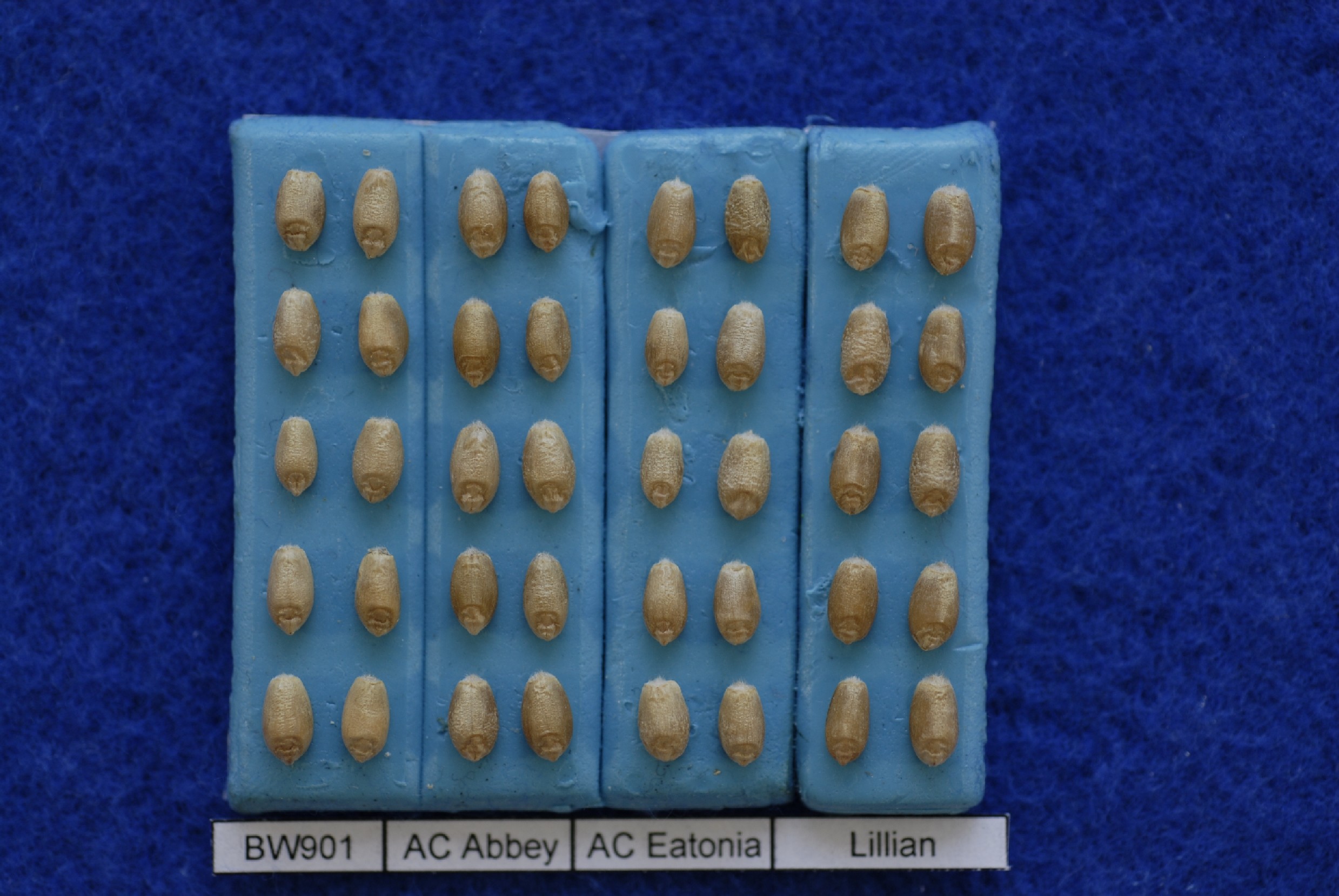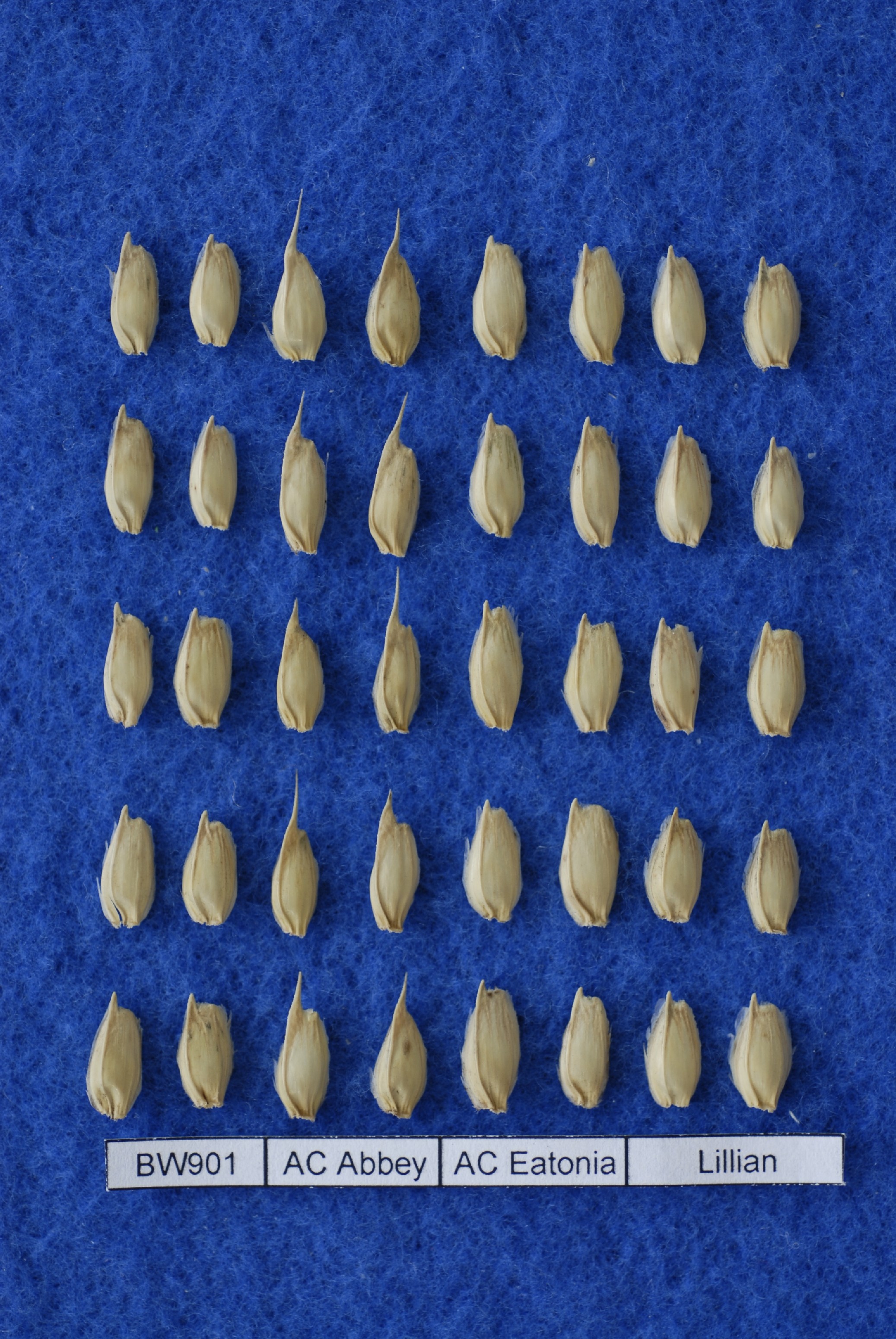AAC Bailey
| Denomination: | 'AAC Bailey' |
|---|---|
| Previously Proposed Denomination: | 'BW901' |
| Botanical Name: | Triticum aestivum |
| Applicant/Holder: |
Agriculture & Agri-Food Canada, Swift Current Research and Development Centre 1 Airport Road P.O. Box 1030 Swift Current, Saskatchewan S9H 3X2 Canada |
| Breeder: |
Ron De Pauw, Agriculture & Agri-Food Canada, Swift Current, Saskatchewan |
| Agent in Canada: |
Agriculture & Agri-Food Canada Office of Intellectual Property and Commercialization c/o Shannon Whyte 107 Science Place Saskatoon, Saskatchewan S7N 0X2 Canada Tel: (204) 999-9887 |
| Application Date: | 2011-04-29 |
| Application Number: | 11-7268 |
| Grant of Rights Date: | 2013-07-04 |
| Certificate Number: | 4568 |
| Date rights surrendered: | 2020-06-16 |
Variety Description
Varieties used for comparison: 'AC Abbey', 'AC Eatonia' and 'Lillian'
Summary: The intensity of anthocyanin colouration on the coleoptile of 'AAC Bailey' is medium to strong whereas it is weak to medium on 'AC Abbey' and 'Lillian' and absent or very weak on 'AC Eatonia'. The frequency of plants with recurved flag leaves is medium to high in 'AAC Bailey' and weak to medium in 'AC Abbey' and 'Lillian' and absent or very low in 'AC Eatonia'. The intensity of anthocyanin colouration of the flag leaf auricles of 'AAC Bailey' is absent or very weak whereas it is medium to strong on 'AC Eatonia'. At maturity, 'AAC Bailey' is taller than 'AC Abbey'. 'AAC Bailey' has thin straw pith in cross section whereas it is medium to thick in 'AC Abbey' and 'Lillian' and medium in 'AC Eatonia'. The spikes of 'AAC Bailey' are apically awnletted whereas they are awned on 'AC Abbey'. The kernel brush hairs of 'AAC Bailey' are short whereas they are medium to long on the reference varieties.
Description:
PLANT: common hard red spring type, intermediate growth habit at the 5-9 tiller stage
SEEDLING (4 leaf stage): medium to strong intensity of anthocyanin colouration of the coleoptile, glabrous sheath and blade of the lower leaves
FLAG LEAF: medium to high frequency of plants with recurved flag leaves, absent or very weak intensity of anthocyanin colouration of the auricles, medium to strong glaucosity of the sheath, glabrous blade and sheath
SPIKE: medium glaucosity at heading, parallel sided shape in profile, medium density, awnlets present
SPIKE AT MATURITY: white, incline attitude, medium hairiness of convex surface of apical rachis segment
CULM: medium glaucosity at heading, straight neck
STRAW (AT MATURITY): thin pith in cross-section
LOWER GLUME: narrow to medium width, short to medium length
LOWER GLUME SHOULDER: mainly medium width with some broad, mainly straight shape
LOWER GLUME BEAK: short, mainly straight with some slightly curved
KERNEL: medium red colour, medium size, oval, rounded to angular cheek shape, short brush hairs, round germ, medium to wide width of crease, medium depth of crease
BREAD MAKING QUALITY: good
DISEASE REACTION: resistant to Leaf rust (Puccinia triticina) and Stem rust (Puccinia graminis f.sp. tritici), moderately resistant to moderately susceptible to Common bunt (Tilletia laevis and Tilletia tritici), Fusarium head blight (Fusarium graminearum, Fusarium species) and Leaf spots (Pyrenophora tritici-repentis, Septoria spp.) and moderately susceptible to Loose smut (Ustilago tritici)
Origin & Breeding History: 'AAC Bailey' (experimental designation 'BW901') is derived from the cross 9505-LP03A/Journey//Lillian made in 2002 at the Semiarid Prairie Agricultural Research Centre of Agriculture and Agri-Food Canada, Swift Current, Saskatchewan. About 10,000 F2 seeds were inoculated with common bunt and planted in a rust epiphytotic nursery. Disease-free, solid-stemmed and early maturing individual plants were selected, threshed and selected for kernel characteristics. Seed of the F3 generation was grown in a contra-season nursery in New Zealand where selections were made based on maturity, plant height and straw strength. The F4, F6 and F8 lines were planted and screened in various locations in Saskatchewan and Alberta (Swift Current, Stewart Valley and Lethbridge) and assessed for agronomic performance, end-use suitability and response to wheat stem saw fly. The F5 and F7 generations were grown in nurseries in New Zealand. Selected F8 lines were screened for resistance to mixtures of loose smut and common bunt. Through this breeding process, the experimental line B0203-KE02B was selected and in 2007, was evaluated in the Western Bread Wheat 'A_1' test and entered in the Western Bread Wheat Cooperative tests from 2008 to 2010 as 'BW901'.
Tests & Trials: Test and trials for 'AAC Bailey' were conducted during the summers of 2010 and 2011 in Swift Current, Saskatchewan. Plot size was 4.6 meters square and consisted of 4 rows. There were 4 replicates arranged in a RCB design. Measured characteristics were based on 20 measurements per variety per year.
Comparison tables for 'AAC Bailey' with reference varieties 'AC Abbey', 'AC Eatonia' and 'Lillian'
Heading (number of days from planting to 50% of heads fully emerged from boot)
| 'AAC Bailey' | 'AC Abbey' | 'AC Eatonia' | 'Lillian' | |
|---|---|---|---|---|
| mean | 51.8 | 51.5 | 53.5 | 56.1 |
Plant height (cm)
| 'AAC Bailey' | 'AC Abbey' | 'AC Eatonia' | 'Lillian' | |
|---|---|---|---|---|
| mean | 105.8 | 95.9 | 108.8 | 104.6 |
| std. deviation | 5.7 | 3.8 | 4.1 | 6.1 |
Click on image for larger view

Wheat: 'AAC Bailey' (left) with reference varieties 'AC Abbey' (centre left), 'AC Eatonia' (centre right) and 'Lillian' (right)
Click on image for larger view

Wheat: 'AAC Bailey' (left) with reference varieties 'AC Abbey' (centre left), 'AC Eatonia' (centre right) and 'Lillian' (right)
- Date modified: